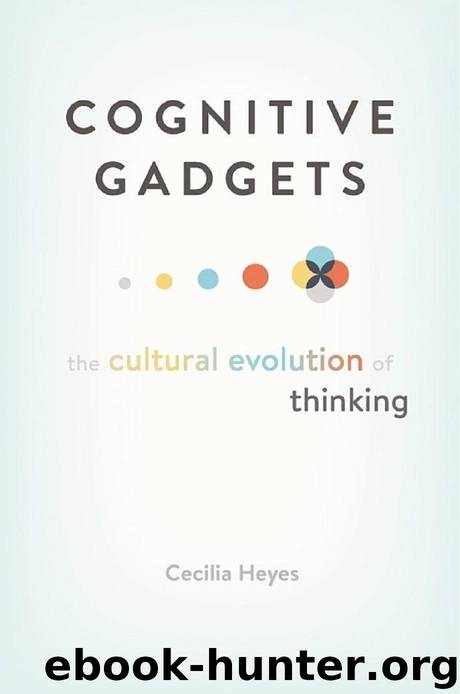Cognitive Gadgets: The Cultural Evolution of Thinking by Cecilia Heyes

Author:Cecilia Heyes [Heyes, Cecilia]
Language: eng
Format: epub
Tags: Psychology, Evolutionary Psychology, Cognitive Psychology & Cognition, Developmental, General, Science, Cognitive Science, Life Sciences, Evolution
ISBN: 9780674985131
Google: lbpTDwAAQBAJ
Amazon: B07BTL33XT
Publisher: Harvard University Press
Published: 2018-04-15T19:00:00+00:00
LEARNING TO READ MINDS
When more than a thousand pairs of five-year-old twins were given a comprehensive battery of mindreading tests, the correlation in performance within pairs was the same, 0.53, for non-identical twins with an average of 50 percent of their genes in common, and for identical twins who have all of their genes common. This indicates a “substantial shared environmental influence but negligible genetic influence on individual differences in theory of mind” (Hughes et al., 2005). In other words, it conflicts with the cognitive instinct view and suggests that learning plays a critical role in the development of mindreading.
However, by themselves, the twin data do not tell us what kind of learning is most important in the development of mindreading. The crucial learning could be of the type postulated by theory-theory, in which the child scientist tests hypotheses against behavioral data; or of the kind envisaged by simulation theory (Goldman, 2006), in which the child works out what others are thinking and feeling through introspection, imagining herself in the same situation as another agent; or, as the cognitive gadget view suggests, the most important learning could be a consequence of teaching. Both theory-theory and simulation theory cast learning to read minds as an individualistic process. The target of learning, the thing-to-be-understood, is other people, but other people do not play an active role in advancing the learning process. They don’t provide the hypotheses or perform the simulations. In contrast, the cognitive gadget view suggests that children are taught how to read minds in much the same way as they are taught how to read print: through scaffolding or “epistemic engineering” (Sterelny, 2012) and explicit instruction.
A “natural experiment” has provided compelling evidence that language-based teaching is crucial in the development of mindreading. The natural experiment was the emergence, in the 1970s, of a new sign language, NSL, among deaf people in Nicaragua. Pyers and Senghas (2009) compared false belief understanding in two adult cohorts of NSL users. They found that the first cohort, who learned NSL when it was still a rudimentary language, were less able to understand false beliefs than the second cohort, who learned NSL approximately ten years later, when it included many more signs for mental states. This suggests that, although the first cohort was ten years older—and therefore had much more time and opportunity to generate and test hypotheses (theory-theory), to reflect on their own mental states (simulation theory), and to observe the behavior of social partners—their understanding of false belief lagged behind that of second cohort. Lacking mental state vocabulary, they had not been able to receive instruction about the mind (Pyers and Senghas, 2009). Furthermore, the NSL findings are supported by a more recent study showing that children in Samoa, where it is considered improper to talk about mental states, develop an understanding of false belief at around eight years of age—four or five years later than children in Europe and North America (Mayer and Träuble, 2013).
In combination with other research involving typically and
Download
This site does not store any files on its server. We only index and link to content provided by other sites. Please contact the content providers to delete copyright contents if any and email us, we'll remove relevant links or contents immediately.
Rewire Your Anxious Brain by Catherine M. Pittman(17589)
Talking to Strangers by Malcolm Gladwell(11876)
The Art of Thinking Clearly by Rolf Dobelli(8841)
Mindhunter: Inside the FBI's Elite Serial Crime Unit by John E. Douglas & Mark Olshaker(7834)
Becoming Supernatural by Dr. Joe Dispenza(7105)
Change Your Questions, Change Your Life by Marilee Adams(6641)
The Road Less Traveled by M. Scott Peck(6634)
Nudge - Improving Decisions about Health, Wealth, and Happiness by Thaler Sunstein(6633)
The Lost Art of Listening by Michael P. Nichols(6472)
Enlightenment Now: The Case for Reason, Science, Humanism, and Progress by Steven Pinker(6405)
Win Bigly by Scott Adams(6311)
Mastermind: How to Think Like Sherlock Holmes by Maria Konnikova(6235)
The Way of Zen by Alan W. Watts(5799)
Daring Greatly by Brene Brown(5640)
Grit by Angela Duckworth(4736)
Big Magic: Creative Living Beyond Fear by Elizabeth Gilbert(4723)
Men In Love by Nancy Friday(4322)
Flow by Mihaly Csikszentmihalyi(4052)
The Four Tendencies by Gretchen Rubin(4024)
